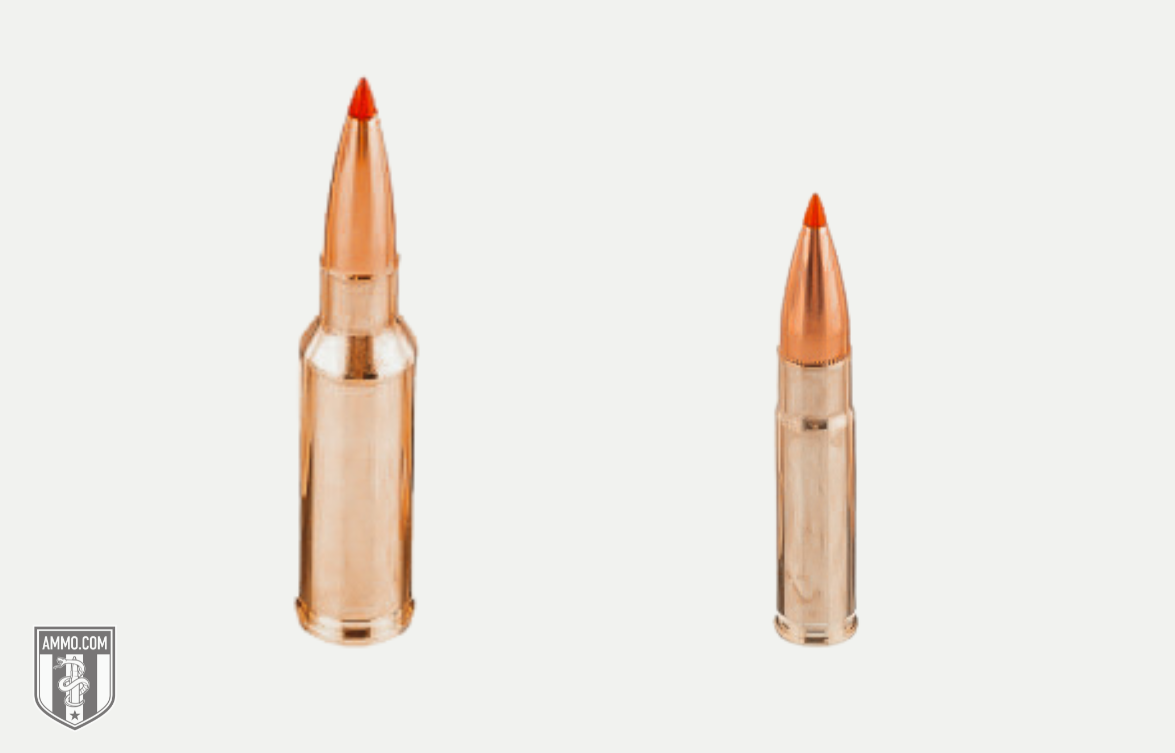8.6 Blackout vs. 300 Blackout: Slow Velocity Battle
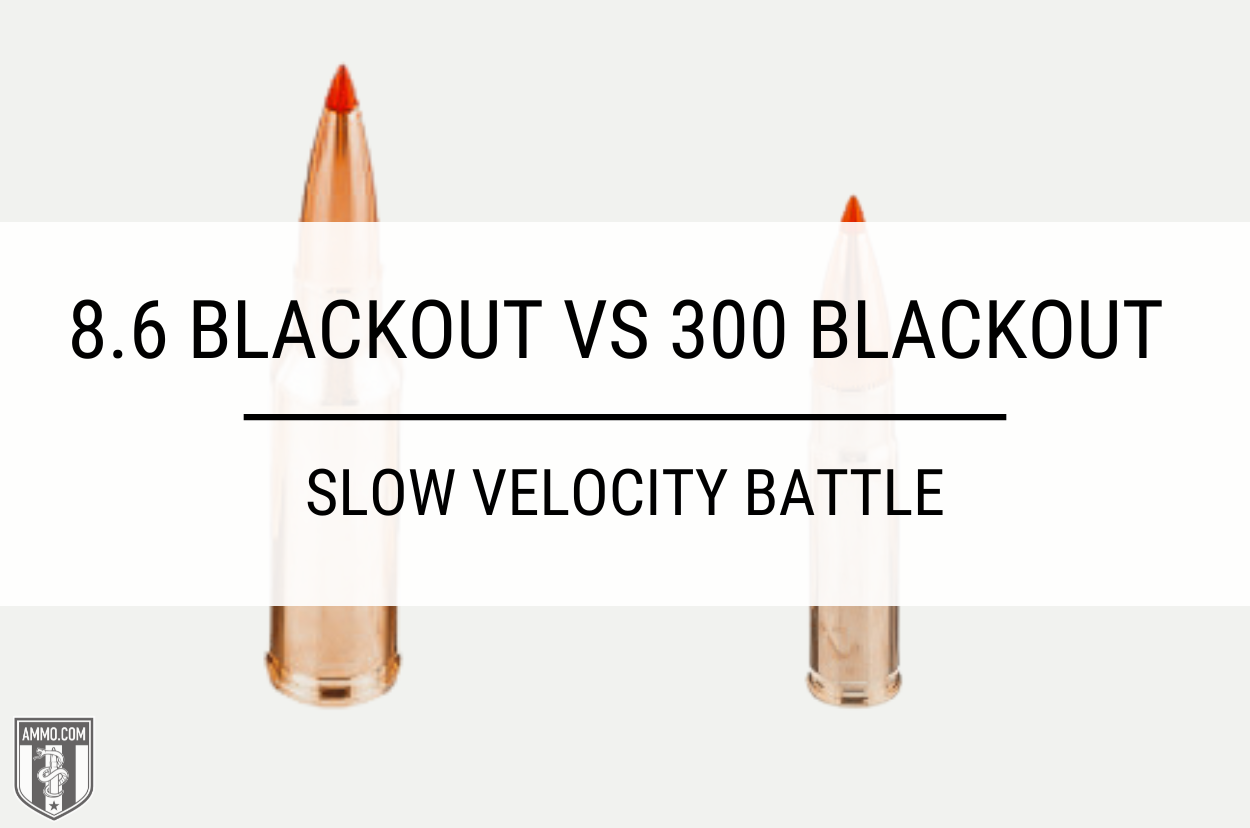 The 8.6mm Blackout was designed for the AR-10 platform, while the 300 AAC Blackout was designed for the AR-15 platform. Can we honestly compare the two?
The 8.6mm Blackout was designed for the AR-10 platform, while the 300 AAC Blackout was designed for the AR-15 platform. Can we honestly compare the two?
You bet!
These cartridges have very similar origins. As you continue reading, you’ll discover which is better based on recoil, trajectory, accuracy, stopping power, and many other factors.
We’ll keep track of the winner of each section, so at the end of the article, you can easily decide if the 8.6 BLK or 300 BLK fits your shooting preferences.
8.6 Blackout vs. 300 Blackout Overview
The 8.6 Blackout is a new cartridge by Faxon Firearms. It's still relatively unproven since it only hit the market in 2022. The 300 Blackout has been around for a few more years, as it was released in 2011. It is already a favorite among many shooters.
Both cartridges take advantage of large-for-caliber bullets to increase terminal performance. These larger projectiles have lower velocities and are not intended for long-range shooting because they have an arching trajectory (as you’ll soon see).
Home defense and hunting are the primary applications for either cartridge – but which one should you choose? Let’s begin with the numbers and move on to the amount of recoil each cartridge produces.
Technical Specs
There is a clear difference between these two cartridges when you place them side by side. The 8.6 BLK is larger than the 300 BLK in every way. The 8.6 BLK fires a larger bullet, has a longer case, and has a greater case capacity than the 300 BLK.
What makes an 8.6 Blackout rifle stand out is its insanely fast 1:3” barrel twist rate. This ensures the heavy bullet will spin at subsonic speeds, stabilizing the copper or bonded projectile for improved accuracy out of a short barrel.
Both cartridges are crafted for subsonic loads and shooting through a suppressor (but are also available as supersonic loads).
The 8.6 Blackout is not currently recognized by SAAMI, so the maximum pressure isn’t listed in the table.
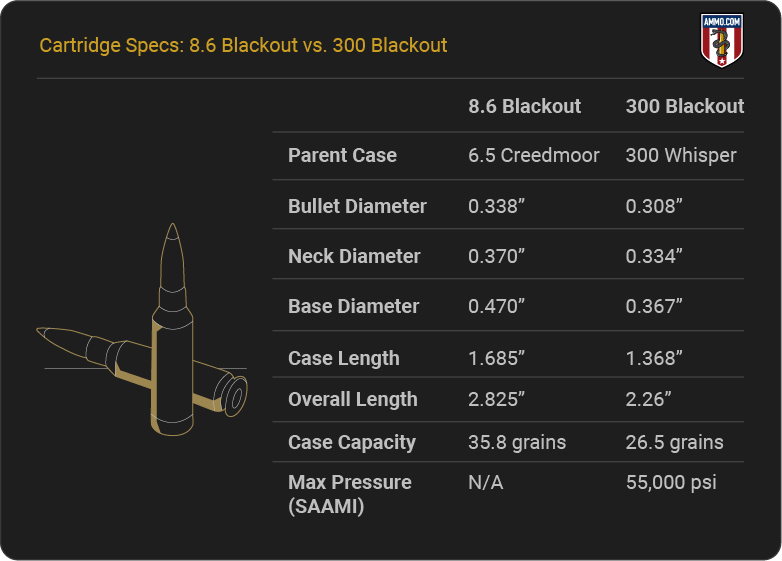
Recoil
The 300 Blackout and 8.6 Blackout are considered low-recoil rounds, especially considering the bullet weight of each cartridge. Other cartridges that use bullets in a similar weight range, often have much more recoil than either of these loads.
You should only expect about 6 ft-lbs of recoil from the 300 BLK. Since the 8.6 BLK is the big brother of the 300 BLK, the 8.6mm BLK will have a little more recoil: around 10 ft-lbs. Neither will make your shoulder sore after a full day at the range, regardless of whether you’re firing a bolt-action rifle or carbine.
While an AR handgun will have a little more recoil (as it has less mass with which to absorb the energy), the difference won’t be significant.
The 300 BLK takes an early lead and wins this section, but to be sure, neither cartridge is a shoulder thumper.
Trajectory
This is another section in which the cartridges are very similar – but this time, not for the benefit of shooters.
The Gorilla 210 grain TSX 8.6mm BLK projectile will drop -32.2” at 300 yards when zeroed at 100 yards with a 1.5” sight height.
The Hornady BLACK 208 grain A-MAX 300 BLK projectile will drop -106.1” at 300 yards when sighted in at 100 yards with a 1.5” sight height.
The Barnes 120 grain JHP FB 300 Blackout will have a similar trajectory (it has -31” of bullet drop at 300 yards) as the 8.6 BLK round mentioned above, although it uses a substantially lighter bullet.
The 8.6 Blackout won’t impress any long-range shooters with its arching trajectory. However, it does boast a flatter trajectory than the 300 Blackout.
Accuracy
Many factors contribute to a round's accuracy, including the shooter, shooting conditions, bullet design, rifle, recoil, and trajectory.
To provide as honest a comparison as possible, we’ll assume the shooter, bullet design, conditions, and rifle are identical and only consider the cartridges' recoil and trajectory.
Since the 300 BLK has less recoil than the 8.6 BLK – but the 8.6mm has a slightly flatter trajectory – we consider this section a draw.
Both cartridges are plenty accurate within 200 yards when loaded with proper bullets.
Ballistic Coefficient
Ballistic coefficient (BC) is a numeric representation of a bullet's ability to overcome frontal air resistance. It also reflects how effectively a bullet resists wind drift. Shooters prefer a high BC, as it means the bullet should more easily overcome wind deflection.
Heavy bullets typically have a higher BC, as it takes more force to disrupt the flight of a heavier projectile than a lighter one. The ballistic coefficient varies from bullet to bullet based on design, weight, and a few other factors.
Both cartridges offer projectiles with a high BC, as they can fire heavy bullets. The 8.6 BLK will have a BC ranging from 0.432 to 0.736. In contrast, the 300 BLK will have a BC ranging from 0.265 to 0.648.
The 8.6 Blackout typically has a higher BC, primarily thanks to its heavier projectiles.
Stopping Power
“Stopping power” is a vague concept. It could refer to the bullet’s capacity for penetration, expansion, or both. Furthermore, any cartridge has the potential to instantly neutralize a threat with proper shot placement.
For the sake of the argument, we’ll focus on muzzle velocity and muzzle energy and how well the bullet maintains its velocity and energy, transferring it to the target. Typically, the more energy a bullet transfers to the target, the more stopping power it will have.
After reviewing several ballistic gel tests, I’m very impressed with the 8.6 Blackout’s terminal performance, which all begins at the muzzle. The muzzle velocity of a 210 grain TSX 8.6mm BLK bullet is 1,970 fps, and the muzzle energy is 1,810 ft-lbs. It conserves 1,209 fps and 682 ft-lbs at 500 yards.
Even though the 300 BLK is considered the little brother, it’s no slouch. A Winchester USA 200 grain OTM 300 BLK bullet has a muzzle velocity of 1,060 fps and a muzzle energy of 498 ft-lbs. It conserves 862 fps and 330 ft-lbs at 500 yards.
The larger 8.6mm Blackout easily wins this section.
Hunting
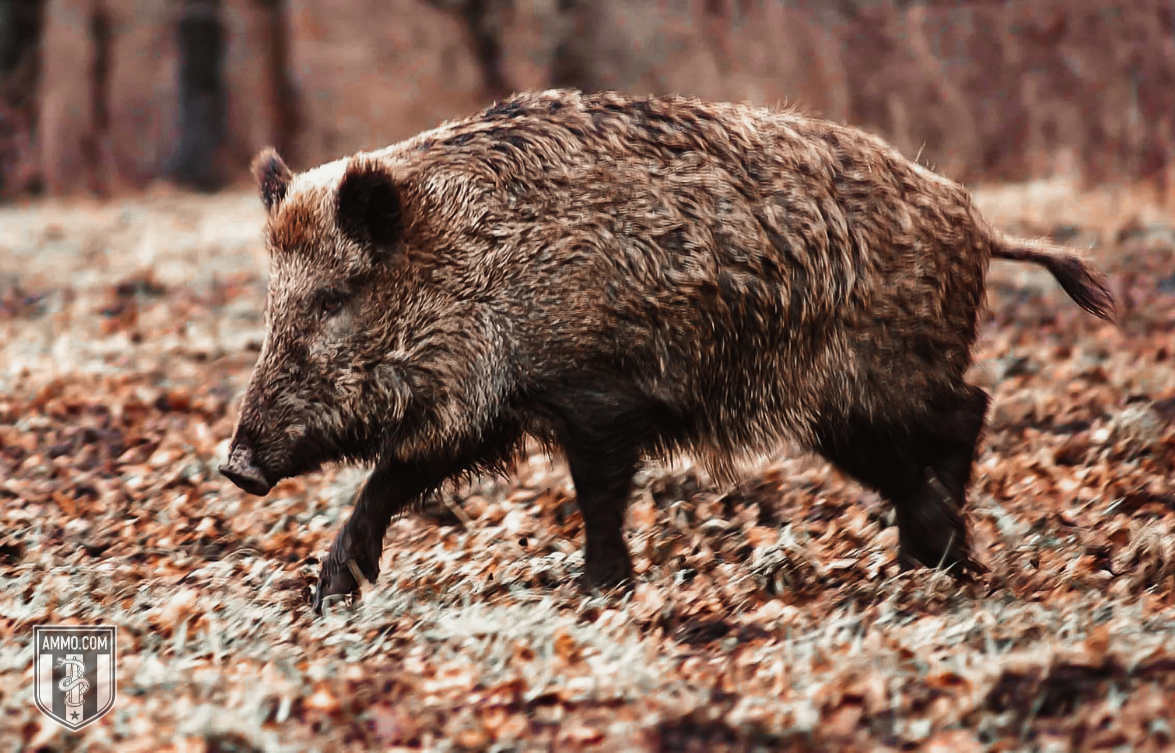
Neither of these rounds is ideal for long-range hunting, although they’re excellent rounds for taking whitetail and hogs within 200 yards. I’ve read stories of the 8.6 BLK causing hogs and deer to reflexively do a backflip upon impact. That seems a bit overkill and can be disheartening to non-hunters, but it ensures a quick, ethical kill.
The 8.6 Blackout cartridge has the upper hand when hunting African big game, as it’s more powerful.
The 8.6 Blackout wins this section, as it is slightly more versatile than the 300 AAC Blackout. However, some hunters prefer smaller projectiles, as they tend to destroy less meat.
Home Defense
As far as rifle cartridges are concerned, home defense is where these two blackout cartridges outperform others. They’re both found in bolt guns and semi-auto carbines (the latter being the better option for home defense), and you can safely fire them suppressed.
The biggest downside to either cartridge is the likelihood of over-penetration. For this reason, I would give a slight edge to the 300 BLK, as it’s less likely to over-penetrate (but does not eliminate the possibility).
The 300 Blackout cartridge would be the one I grab to defend my home.
Ammo & Rifle Cost/Availability
Since the 300 BLK has been around longer, more companies have produced rifles and ammunition for this cartridge. It is much more abundant and less expensive than the 8.6 BLK.
If you’re looking for a more budget-friendly option, the 300 BLK is the way to go, though I wouldn’t consider either cartridge cheap.
Ability To Reload
Reloading either blackout cartridge is possible. As a matter of fact, handloading is how most 8.6 Blackout owners are getting ammo since the major ammunition manufacturers are still a little reluctant to go all in on this round.
Once again, because the 300 BLK is the older cartridge, there’s more reloading information available, but I don’t believe that justifies it winning this section. This section is a draw.
8.6 Blackout vs. 300 Blackout Ballistics
If you’re a numbers person, this portion of the article was created for you! Below you’ll find the ballistics of common 8.6 BLK and 300 BLK rounds.
8.6 Blackout Ballistics
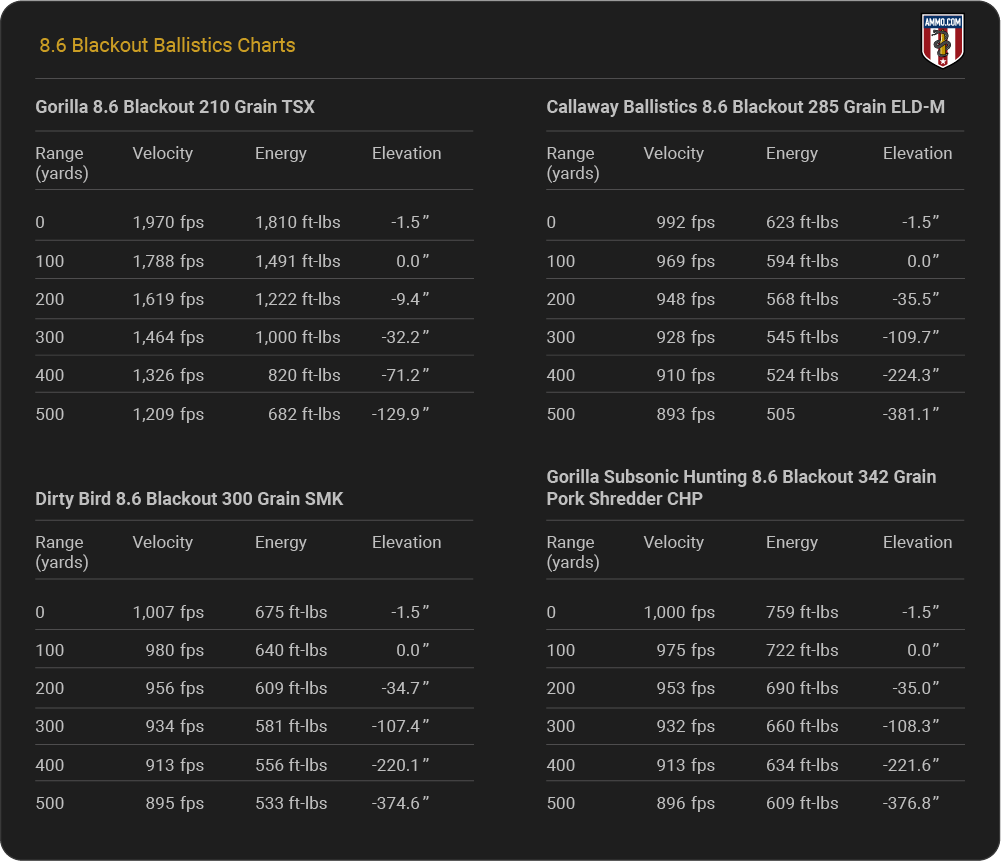
Check out our in-depth article for a deeper dive into 8.6 Blackout ballistics.
Administrative Note: The information above comes from the manufacturer. The actual ballistics obtained with your firearm can vary considerably from the advertised ballistics. Also, ballistics can vary from lot to lot with the same brand and type load. When manufacturer ballistic data was unavailable, ballistics were calculated using a ballistics calculator.
300 Blackout Ballistics
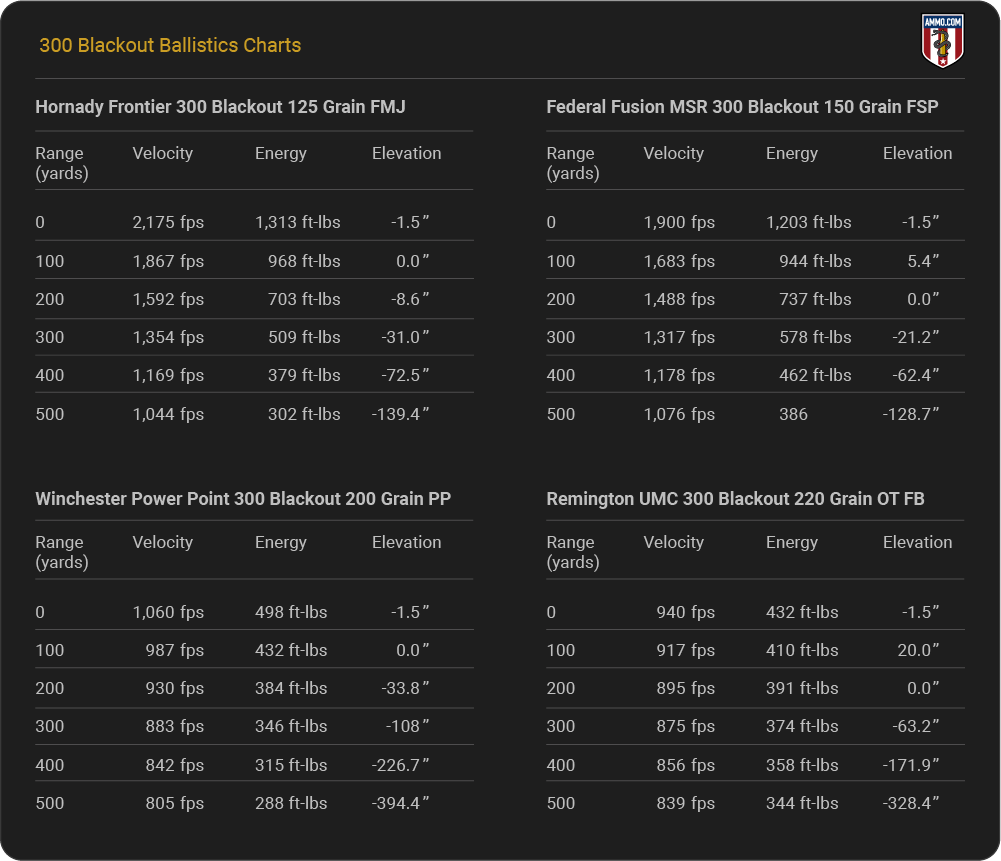
Check out our in-depth article for a deeper dive into 300 Blackout ballistics.
Administrative Note: The information above comes from the manufacturer. The actual ballistics obtained with your firearm can vary considerably from the advertised ballistics. Also, ballistics can vary from lot to lot with the same brand and type load. When manufacturer ballistic data was unavailable, ballistics were calculated using a ballistics calculator.
Brief 8.6 Blackout History
Released to the public in 2022, the 8.6 Blackout has a short history.
Q, LLC developed the 8.6 BLK by shortening a 6.5 Creedmoor case and necking it up to accept a 0.338” (8.6mm) diameter bullet.
It performs well (at close range) in bolt-action and semi-auto AR-10 rifles with short barrels using supersonic or subsonic loads.
While it has shown promising hunting applications, the 8.6 BLK remains unproven to most of the public. We shall see if it establishes a foothold in the market or if it’s another soon-to-be-forgotten cartridge.
Brief 300 Blackout History
The 300 AAC Blackout was developed by a team, including Robert Silvers of Advanced Armament Corporation (AAC), who based it on the 300 Whisper wildcat cartridge. It was approved by SAAMI in 2011.
The 300 BLK was designed to achieve a complete powder burn in short-barrel rifles (SBRs), typically with a suppressor (also called a can or silencer).
The supersonic and subsonic loads fill the stopping power need, whereas the 5.56 NATO and 9mm were lacking in close-range engagements on the battlefield.
While it’s not a long-range rifle, it’s still loved by many hog and deer hunters across the US. It remains as popular as ever. However, the 8.6mm Blackout claims to be better.
Parting Shots: 8.6 Blackout vs. 300 Blackout
Now that you’ve finished reading our 8.6 Blackout vs. 300 Blackout article, it’s time to tally up the wins for each cartridge. The 8.6 BLK won four sections (trajectory, ballistic coefficient, stopping power, and hunting), whereas the 300 BLK won three sections (recoil, home defense, and cost/availability). Accuracy and ability to reload were ties.
So there you have it, a not-so-scientific conclusion that the 8.6 Blackout is better than the 300 Blackout.
But is it better for your situation? That’s for you to decide!
Here are more articles on the 300 Blackout to help: 300 Blackout vs. 223, 300 Blackout vs. 5.56 NATO, 300 Blackout vs. 308 Winchester and 300 Blackout vs. 7.62x39.
Ammo Comparisons
- .308 vs 5.56
- 6.5 Creedmoor vs .308
- .300 Blackout vs .308
- .300 Win Mag vs .308
- .243 vs .308
- .308 vs .30-06
- 7mm-08 vs .308
- .270 vs .308
- 7.62x39 vs .308
- .223 vs .308
- .338 Lapua vs .308
- .380 ACP vs 9mm
- .223 vs 5.56
- .300 Blackout vs 5.56
- 9mm vs 45 ACP
- 9mm vs 40 S&W
- .357 SIG vs 9mm
- 10mm vs 9mm
- 9mm vs 9mm Luger
- .243 vs .270
- .300 Win Mag vs .30-06
- .270 vs .30-06
- .40 vs .45
- 38 Special vs 357
- 9mm vs 40 vs 45
- 5.56 vs 7.62x39
- 338 Lapua vs .30-06
- .30-30 vs .30-06
- 300 PRC vs 338 Lapua
- .30-06 vs 7mm
- 300 Win Mag vs 338 Lapua
- 300 PRC vs 300 Win Mag
- 300 WSM vs 300 Win Mag
- 338 Win Mag vs 338 Lapua
- 12 Gauge vs 20 Gauge
- 10mm vs 357 Mag
- .30-30 vs 7.62x39
- 224 Valkyrie vs 22-250
- 17 HMR vs 22 Mag
- 7.62x39 vs .300 Blackout
- 45 ACP vs 45 Auto
- 45-70 vs 30-30
- 300 Blackout vs 223
- 357 Magnum vs 9mm
- 350 Legend vs 300 Blackout
- 224 Valkyrie vs 223
- 45 ACP vs 38 Super
- 6.5 Grendel vs .308
- 17 HMR vs 22 LR
- 10 Gauge vs 12 Gauge
- 22-250 vs 223
- 45 Colt vs 45 ACP
- 350 Legend vs 30-30
- 5.7x28 vs 223
- 5.7 vs 9mm
- 5.56 vs 5.7
- 22 vs 9mm
- Buckshot vs Birdshot
- 450 Bushmaster vs 308
- 450 Bushmaster vs 223
- Buckshot vs Slug
- 6.5 Grendel vs 5.56 vs 223
- 6mm ARC vs 6.5 Grendel
- 44 vs 45
- 458 SOCOM vs 5.56
- 357 vs 44
- 32 ACP vs 380
- 300 Win Mag vs 338 Win Mag vs 338 Lapua Mag
- 450 Bushmaster vs 458 SOCOM vs 50 Beowulf
- 6mm Creedmoor vs 6.5 Creedmoor
- TMJ vs FMJ
- 44 Special Vs 44 Magnum
- 45 90 vs 45 70
- 6.8 Western vs 6.8 SPC
- 50 Beowulf vs 50 BMG
- 26 Nosler vs 6.5 PRC
- 28 Gauge vs 410
- 6.8 SPC vs 5.56
- 6.8 SPC vs 6.5 Grendel
- 6.8 Western vs 7mm Rem Mag vs .28 Nosler
- 6.8 Western vs 6.5 Creedmoor
- 22 Hornet vs 223
- 6.8 Western vs 6.5 PRC
- .410 vs 12 Gauge
- .410 vs 20 Gauge
- 22 LR vs 22 Mag
- 6mm ARC vs 243
- 7mm-08 vs 270
- 243 vs 6.5 Creedmoor
- Nickel vs Brass Casing
- 204 Ruger vs 223
- 50 Beowulf vs 5.56
- 260 Remington vs 6.5 Creedmoor
- 6mm Remington vs 243
- 28 Nosler vs 300 PRC
- 50 Beowulf vs 50 AE
- 22 Nosler vs 22-250
- 450 Marlin vs 45-70
- 300 Win Mag vs 300 Norma
- 458 SOCOM vs 300 Blackout
- 38-55 vs 45-70
- 22 Hornet vs 22 LR
- 300 Norma vs 338 Lapua
- 338 Lapua vs 50 BMG
- 28 Nosler vs 300 Win Mag
- 28 Nosler vs 6.5 Creedmoor
- 204 vs 22-250
- 458 SOCOM vs 45 70
- 44 40 vs 45 70
- 6.8 SPC vs 6.5 Creedmoor
- 450 Bushmaster vs 30-06
- 7mm Rem Mag vs 300 Win Mag
- 30 Carbine vs 223
- 25-06 vs 30-06
- 26 Nosler vs 28 Nosler
- 16ga vs 12ga
- 30 06 vs 7.62 x54R
- 9mm Makarov vs 9mm Luger
- 350 Legend vs 223
- 30 Carbine vs 5.56
- 6.5x55 vs 6.5 Creedmoor
- 6.5 Creedmoor vs 270 vs 25-06
- M193 vs M855
- 450 Bushmaster vs 458 SOCOM
- 6.5 Grendel vs 6.5 Creedmoor
- 350 Legend vs 5.56
- .277 Fury vs 6.8 SPC
- 277 Fury vs 300 Win Mag
- 10mm vs .45 ACP
- 277 Fury vs 223
- 6.8 SPC vs 300 Blackout
- 6.5 PRC vs 6.5 Creedmoor
- 277 Fury vs 308
- 277 Fury vs 6.5 Creedmoor
- 350 Legend vs 450 Bushmaster
- 277 Fury Vs 5.56 NATO
- 10mm vs 40S&W
- 32 ACP vs 9mm
- 32 Special vs 9mm
- 8.6 Blackout vs 300 Blackout
- 30 Super Carry vs. 9mm
- 5.56 vs 9mm
- .50 Action Express vs 9mm
- 7.62x25 vs. 9mm
- 10mm vs 44 Magnum
- 300 Blackout vs 300 Win Mag
- 6.5 Grendel vs 300 Blackout
- 460 Rowland vs 10mm
- 300 RUM vs 300 PRC
- 300 Norma vs 300 PRC
- 45 GAP vs 45 ACP
- 7mm PRC vs 300 Win Mag
- 300 PRC vs 6.5 Creedmoor
- 300 PRC vs 308
- 357 SIG vs 357 Mag
- 7.62x39 vs 7.62x51
- 243 Win vs 223 Rem
- 30 Nosler vs 300 PRC
- 6.5 Creedmoor vs. 30-06 Springfield
- 450 S&W vs. 44 Magnum
- 6.5 Creedmoor vs. 300 Win Mag
- 454 Cassull vs. 45-70 Govt
- 454 Cassull vs. 44 Mag
- 7.62x54r vs. 308 Winchester
- 22 ARC vs. 223 Rem
- Subsonic vs. Supersonic Ammo
